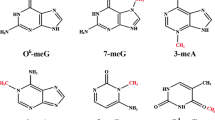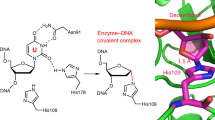Abstract
Cellular and organism aging have been correlated with accumulated DNA damage (1,2). 8-oxo-7,8-dihydrodeoxyguanine (8-oxoG or GO) is one of the most stable products of oxidative DNA damage. The formation of GO in DNA, if not repaired, can lead to misincorporation of A opposite to the GO lesion and result in G:C to T:A transversions (3–6). In Escherichia coli, a family of enzymes, MutY, MutM, and MutT, is involved in defending against the mutagenic effects of GO lesions (7–9). The E. coli MutY is an adenine glycosylase active on DNA containing A/GO, A/G, and A/C mismatches (7,10–15) and also has a weak guanine glycosylase activity on G/GO-containing DNA (15a,15b). MutY removes misincorporated adenines paired with GO lesions and reduces the GO mutational effects. The 39-kDa MutY protein from E. coli is an ironsulfur protein. The MutY protein was shown by Tsai-Wu et al. (16) to have both DNA glycosylase and apurinic/apyrimidinic (AP) lyase activities. Recent results show that MutY and the N-terminal catalytic domain can be trapped in a stable covalent enzyme-DNA intermediate in the presence of sodium borohydride (17–19) and support that MutY contains both DNA glycosylase and AP lyase activities. The DNA glycosylase activity removes the adenine bases from the A/GO, A/G, and A/C mismatches (16) and the AP lyase activity cleaves the first phosphodiester bond 3′ to the AP site (12,16). Apparent dissociation constants are 0.066, 5.3, and 15 nM for A/GO-, A/G-, and A/Ccontaining DNA, respectively (20).
Access this chapter
Tax calculation will be finalised at checkout
Purchases are for personal use only
Similar content being viewed by others
References
Ames, B. N. and Gold, L. S. (1991) Endogenous mutagens and the causes of aging and cancer. Mutat. Res. 250, 3–16.
Kasai, H. and Nishimura, S. (1991) Formation of 8-hydroxyguanine in DNA by oxygen radicals and its biological significance, in Oxidative stress: oxidants and antioxidants (Sies H., ed.), Academic, London, pp. 99–116.
Moriya, M. (1993) Single-stranded shuttle phagemid for mutagenesis studies in mammalian cells: 8-Oxoguanine in DNA induces targeted G.C to T.A transversions in simian kidney cells. Proc. Natl. Acad. Sci. USA 90, 1122–112
Moriya, M., Ou, C., Bodepudi, V., et al. (1991) Site-specific mutagenesis using a gapped duplex vector: a study of translesion synthesis past 8-oxodeoxyguanosine in Escherichia coli. Mutat. Res. 254, 281–288.
Wood, M. L., Dizdaroglu, M., Gajewski, E., and Essigmann, J. M. (1990) Mechanistic studies of ionizing radiation and oxidative mutagenesis: genetic effects of single 8-hydroxyguanine (7-hydro-8-oxoguanine) residue inserted at a unique site in a viral genome. Biochemistry 29, 7024–7032.
Cheng, K. C., Cahill, D. S., Kasai, H., et al. (1991) 8-Hydroxyguanine, an abundant form of oxidative DNA damage, causes G-T and A-C substitutions. J. Biol. Chem. 267, 166–172.
Michaels, M. L. and Miller, J. H. (1992) The GO system protects organisms from the mutagenic effect of the spontaneous lesion 8-hydroxyguanine (7,8-dihydro-8-oxo-guanine). J. Bacteriol. 174, 6321–6325.
Tchou, J. and Grollman, A. P. (1993) Repair of DNA containing the oxidatively-damaged base 8-hydroxyguanine. Mutat. Res. 299, 277–287.
Tajiri, T., Maki, H., and Sekiguchi, M. (1995) Functional cooperation of MutT, MutM and MutY proteins in preventing mutations caused by spontaneous oxidation of guanine nucleotide in yEscherichia coli. Mutat. Res. 336, 257–267.
Au, K. G., Cabrera, M., Miller, J. H., and Modrich, P. (1988) Escherichia coli mutY gene product is required for specific A/G to C:G mismatch correction. Proc. Natl. Acad. Sci. USA 85, 9163–9166.
Lu, A-L. and Chang, D.-Y. (1988) Repair of single base pair transversion mismatches of Escherichia coli in vitro: correction of certain A/G mismatch is independent of dam methylation and host mutHLS gene functions. Genetics 118, 593–600.
Lu, A-L. and Chang, D.-Y. (1988) A novel nucleotide excision repair for the conversion of an A/G mismatch to C/G base pair in E. coli. Cell 54, 805–812.
Michaels, M. L., Cruz, C., Grollman, A. P., and Miller, J. H. (1992) Evidence that MutM and MutY combine to prevent mutations by an oxidatively damaged form of guanine in DNA. Proc. Natl. Acad. Sci. USA 89, 7022–7025.
Radicella, J. P., Clark, E. A., and Fox, M. S. (1988) Some mismatch repair activities in Escherichia coli. Proc. Natl. Acad. Sci. USA 85, 9674–9678.
Su, S.-S., Lahue, R. S., Au, K. G., and Modrich, P. (1988) Mispair specificity of methyl-directed DNA mismatch correction in vitro. J. Biol. Chem. 263, 6829–6835.
Li, X., Wright, P. M., and Lu, A.-L. (2000) The C-terminal domain of MutY glycosylase determines the 7,8-dihydro-8-oxo-guanine specificity and is crucial for mutation avoidance. J. Biol. Chem., in press.
Zhang, Q.-M., Ishikawa, N., Nakahara, T., and Yonei, S. (1998) Escherichia coli MutY protein has a guanine-DNA glycosylase that acts on 7,8-dihydro-8-oxoguanine:guanine mispair to prevent spontaneous G:C to C:G transversions. Nucelic Acids Res. 26, 4669–4675.
Tsai-Wu, J.-J., Liu, H.-F., and Lu, A-L. (1992) Escherichia coli MutY protein has both N-glycosylase and apurinic/apyrimidinic endonuclease activities on A.C and A.G mispairs. Proc. Natl. Acad. Sci. USA 89, 8779–8783.
Lu, A-L., Yuen, D. S., and Cillo, J. (1996) Catalytic mechanism and DNA substrate recognition of Escherichia coli MutY protein. J. Biol. Chem. 27, 24,138–24,143.
Manuel, R. C. and Lloyd, R. S. (1997) Cloning, overexpression, and biochemical characterization of the catalytic domain of MutY. Biochemistry 36, 11,140–11,152.
Gogos, A., Cillo, J., Clarke, N. D., and Lu, A-L. (1996) Specific recognition of A/G and A/8-oxoG mismatches by Escherichia coli MutY: removal of the C-terminal domain preferentially affects A/8-oxoG recognition. Biochemistry 35, 16,665–16,671.
Lu, A-L., Tsai-W, J.-J., and Cillo, J. (1995) DNA determinants and substrate specificities of Escherichia coli MutY. J. Biol. Chem. 270, 23,582–23,588.
Yeh, Y.-C., Chang, D.-Y., Masin, J., and Lu, A-L. (1991) Two nicking enzymes systems specific for mismatch-containing DNA in nuclear extracts from human cells. J. Biol. Chem. 266, 6480–6484.
McGoldrick, J. P., Yeh, Y.-C., Solomon, M., Essigmann, J. M., and Lu, A.-L. (1995) Characterization of a mammalian homolog of the Escherichia coli MutY mismatch repair protein. Mol. Cell. Biol. 15, 989–996.
Lu, A-L. and Fawcet, W. P. (1998) Characterization of the recombinant MutY homolog, an adenine DNA glycosylase, from Schizosacchromyces pombe. J. Biol. Chem. 273, 25,098–25,105.
Slupska, M. M., Baikalov, C., Luther, W. M., Chiang, J.-H., Wei, Y.-F., and J. H. Miller. (1996) Cloning and sequencing a human homolog (hMYH) of the Escherichia coli mutY gene whose function is required for the repair of oxidative DNA damage. J. Bacteriol. 178, 3885–3892.
Slupska, M. M., Luther, W. M., Chiang, J. H., Yang, H., and Miller, J. H. (1999) Functional expression of hMYH, a human homolog of the Escherichia coli MutY protein. J. Bacteriol. 181, 6210–6213.
Takao, M., Zhang, Q. M., Yonei, S., and Yasui, A. (1999) Differential subcellular localization of human MutY homolog (hMYH) and the functional activity of adenine:8-oxoguanine DNA glycosylase. Nucleic Acids Res. 27, 3638–3644.
Tsai-Wu, J.-J., Su, H.-T., Wu, Y.-L., Hsu, S.-M., and Wu, C. H. H. (2000) Nuclear localization of the human MutY homologue hMYH. J. Cell. Biochem., in press.
Lu, A-L. and Hsu, I. C. (1992) Detection of single DNA base mutations with mismatch repair enzymes. Genomics 14, 249–255.
Hsu, I.-C., Yang, Q. P., Kahng, Y. W., and Xu, J.-F. (1994) Detection of DNA point mutations with DNA mismatch repair enzymes. Carcinogenesis 15, 1657–1662.
Maxam, A. M. and Gilbert, W. (1980) Sequenceing end-labelled DNA with base-specific chemical cleavage. Methods Enzymol. 65, 499–560.
Bradford, M. (1976) A rapid and sensitive method for the quantitation of microgram quantities of protein utilizing the principle of protein-dye binding. Anal. Biochem. 72, 248–254.
Leatherbarrow, R. J. (1987) Enzfitter: A Non-linear Regression Analysis Program for IBM PC, Elsevier Science, Amsterdam.
Laemmli, U. K. (1970) Cleavage of structural protein during the assembly of the head of bacteriophage T4. Nature 227, 680–685.
Author information
Authors and Affiliations
Editor information
Editors and Affiliations
Rights and permissions
Copyright information
© 2000 Humana Press Inc.
About this protocol
Cite this protocol
Lu, AL. (2000). Repair of A/G and A/8-oxoG Mismatches by MutY Adenine DNA Glycosylase. In: Vaughan, P. (eds) DNA Repair Protocols. Methods in Molecular Biology™, vol 152. Humana Press. https://doi.org/10.1385/1-59259-068-3:3
Download citation
DOI: https://doi.org/10.1385/1-59259-068-3:3
Publisher Name: Humana Press
Print ISBN: 978-0-89603-643-7
Online ISBN: 978-1-59259-068-1
eBook Packages: Springer Protocols




